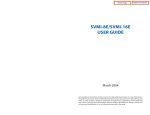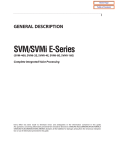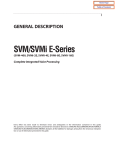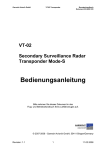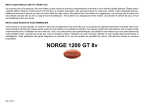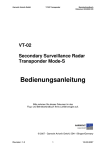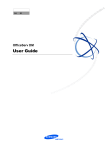Download E-Mail Gateway Application
Transcript
Home Page Table of Contents E-Mail Gateway Application [SVMi-8E and SVMi-16E] Table of Contents 1 Goal 3 Sample Microsoft Outlook Inbox 4 2 Functionality 5 3 Formula to Calculate the Size of an E-Mail Message for a Voice Message of a Given Length 6 4 What happens to the original Voice Messages? 8 5 Benefits 9 Sample Displays of Subject Field Data that may appear in the Inbox 9 6 7 How to Get Started 10 SVMi LAN Connector 13 Default Socket.cfg File 10 Mail Server Information for System Wide Parameters 10 Mail Server Information for MClass 10 Subscriber Information 11 Screens and Parameters Associated with the E-Mail Gateway Functionality 13 System Parameters—Page 1 13 MAC Address 13 Maximum E-Mail Subscribers 13 System Wide Parameters—Page 4 14 SMTP Server 14 Q Host ID 14 Q Port 14 Q SMTP User ID 14 1 Home Page Table of Contents Table of Contents Q Password 14 Q Domain 14 Addressing 15 Q Report 15 Q Reply To 15 Q Time Zone 15 Q Daylight Savings 15 Q License Key 15 Mailbox Block—Page 4 E-Mail Addressing 16 Q Enable E-Mail Gateway Support 16 Q From 16 Q Deliver MSG 16 Q Notify Only 16 Q E-Mail Address Syntax 16 MClass Block—Page 4 17 SMTP Server 17 Q Host ID 17 Q Port 17 Q STMP User ID (Optional) 17 Q Password (Optional) 17 Q Domain (Optional) 17 Delivery Controls 17 Q Attempts 17 Q Retry Interval 17 Message Retention Controls 2 16 18 Q Adjust Message Retention 18 Q Message Retention to Use 18 Port Activity Command 18 “MAC” 18 “NET” 19 “STAT” (Status) 21 Home Page Table of Contents 1 Goal The goal and scope of this project is very simple: ■ ■ ■ Forward Voice and Fax Mail messages to any E-Mail Inbox. Apply E-Mail Gateway functionality to both the SVMi-8E and SVMi-16E. Have NO additional Hardware or Hardware upgrade requirements (as long as applying to a SVMi-8E or SVMi16E). — Making this marketable to all SVMi-8E and SVMi-16E units already sold and installed. ■ Minimal interaction with the Customer's Network: — The only interaction to the Customer LAN is to connect the SVMi LAN port to their Network via customer provided Hub, Switch, and/or Router. — Mail Server "May" require that a user name and password be created for the SVMi. — NO software to be added to the Customer's Network Servers. — NO software or modification to the Client's PC, Laptop, and/or mobile device. IMPORTANT NOTE: There may also be other limitations set by their Mail Servers that may need to be addressed with their IT department. There are two small qualifications: 1. The subscriber's Mail Server MUST support SMTP. 2. The subscriber's PC must offer them some means to listen to '.WAV' files. What makes this so simple is its implementation. There is NO software to add to the Network servers. There is also NO software to add to the clients PC. Voice and/or FaxMail messages will simply be forwarded to the Subscriber's Inbox as an e-mail message with a WAV and/or TIFF file attachment. IMPORTANT NOTE: The clients PC must be equipped with a .Wav player and/or TIFF viewer. Most current versions of Windows and other OS have default players and viewers built in. If on an installation a Client PC is not equipped with some type of player or viewer, one must first be obtained and installed. Samsung will not provide these software or hardware options. The SVMi with the E-Mail Gateway functionality acts as another client on the network. Though we consider the SVMi to be a Voice Processing or Communications Server it is NOT a Mail Server. It attaches or logs onto the mail server as a "client" 3 Home Page Table of Contents Goal Sample Microsoft Outlook Inbox The above sample is of a Microsoft Outlook Inbox containing E-Mail Gateway Delivery Messages. The E-Mail Gateway samples are easy to spot. The Subject begins with either,Voice Message,Voice Reminder, or Fax Message. 4 Home Page Table of Contents 2 Functionality There are two parts to the E-Mail Gateway; E-Message Delivery and E-Message Notification. 1. E-Message Delivery:Voice (.wav) and/or Fax (.tiff ) Mail Messages are "delivered" to your Inbox with the appropriate attached file. 2. E-Message Notification: You will receive an e-mail, with NO attachments, notifying you that you have a Voice and/or Fax Mail Message in your Voice Mail Box. ■ Subscriber can use either E-Message Delivery and/or E-Message Notification. ■ Subscriber can have multiple e-mail addresses. — E-Message Notification can be set to one address while E-Message Delivery is set to another. With either type, if Caller ID (CID) is enabled and received, then the callers Phone number will appear in the subject field along with the Date and Time stamp of the Voice Message originally recorded in the SVMi Voice Mail Box. ■ If the caller is also a subscriber on the system and the E-Mail Gateway was set up with a valid "Reply To" address, the Subscriber's name will also appear in the "From" field. Otherwise, the "From" field will display SVMi-8E or SVMi-16E. ■ Client will use their PC's Multi-Media kit (equipped with either speakers and/or a headset) to listen to messages delivered to their Inbox. IMPORTANT NOTE: If the PC/Laptop/PDA/Cell Phone/etc… are not equipped with hardware and software capable of playing a '.WAV' file then the E-Mail Gateway will not work for them until they add some method to listen to '.WAV' files delivered to their Inbox. The same applies to Fax Mail messages, if the device the subscriber is using does not support the viewing of '.TIFF' files, then the E-Mail Gateway for Fax Mail will not work for them until they add some method to view .tiff files delivered to their inbox. ■ No Synchronization between message activities performed on the SVMi and the SMTP Server. — Messages listened to, forwarded, deleted, and/or saved within an e-mail inbox will NOT effect the status of that same new message in the SVMi or the MWI (Message Waiting Indicator) associated with that message on the phone. — Also messages listened to in the SVMi, from a phone, will not change the Unread/Read status of the same message in an e-mail inbox. — However, the SVMi Administrator can adjust parameters per subscriber or group of subscribers that decide how, when, or if to delete the original Voice message after it is SENT to the SMTP Server. 5 Home Page Table of Contents 3 Formula to Calculate the Size of an E-Mail Message for a Voice Message of a Given Length E-Mails with voice attachments are sent as MIME formatted messages with Base64 encoded WAV files. SVMi voice messages are recorded with either 8000 (32kbps) or 6000 (24kbps) samples per second. This is based on the Field in System Wide Parameters that says; "Use 32 K/Bit(s) Prompts"….."Y/N" WAV file format uses WAV file header is WAV file trailer is Base64 encoding uses MIME formatting 8 bits (1 byte) per sample. 56 bytes. 32 bytes. 4 bytes for every 3 bytes of WAV file, plus 2 bytes for every line (54 bytes). adds approximately an additional 1000 bytes. 32k bps Formula: WAV File Size = ( (Number of seconds) * (8000 samples per second) * (1 byte per sample) ) + (56 bytes header) + (32 bytes trailer) 24k bps Formula: WAV File Size = ( (Number of seconds) * (6000 samples per second) * (1 byte per sample) ) + (56 bytes header) + (32 bytes trailer) Base64 Encode Formula: Attachment Size = ( (WAV File Size) * (4/3) ) + ( (WAV File Size / 54) * 2) MIME Format: Base64 + 1000 bytes 6 Home Page Table of Contents Formula to Calculate the Size of an E-Mail Message for a Voice Message of a Given Length Length of Message (in seconds) Size of WAV File Base64 Attachment MIME Formatted 32kbps 24kbps 32kbps 24kbps 32kbps 24kbps 2 16,088 12,088 22,047 16,565 23,047 17,565 5 40,088 30,088 54,935 41,232 55,935 42,232 10 80,088 60,088 109,750 82,343 110,750 83,343 15 120,088 90,088 164,565 123,454 165,565 124,454 20 160,088 120,088 219,380 164,565 220,380 165,565 30 240,088 180,088 329,009 246,787 330,009 247,787 60 (1 min) 480,088 360,088 657,898 493,454 658,898 494,454 120 (2 min) 960,088 720,088 1,315,676 986,787 1,316,676 987,787 180 (3 min) 1,440,088 1,080,088 1,973,454 1,480,121 1,974,454 1,481,121 300 (5 min) 2,400,088 1,800,088 3,289,009 2,466,787 3,290,009 2,467,787 600 (10 min) 4,800,088 3,600,088 6,577,898 4,933,454 6,578,898 4,934,454 7 Home Page Table of Contents 4 What happens to the original Voice Messages? Though there are no controls that can be set by the individual subscribers, there are parameters that can be set for an individual or group of subscribers by the Voice Mail administrator. The most important of these is what do you want to do with the original Voice Message after it is SENT via e-mail to your Inbox? Your Choices are: 1. Adjust Message Retention Yes or No. ■ NO: means follow the Message Retention timer that is set on page one of the MClass. The default setting for the Message Retention timer is set at 9999 Days. Subscribers using this setting would have to manually listen to, delete, and/or save the voice message in their Voice Mail Box from a phone. ■ YES: means that messages left for subscribers using this MClass will not follow the Message Retention Timer on Page one of the MClass but will now follow the "Message Retention to Use" timer on Page 4 of the MClass. 2. Message Retention to Use: If adjust Message Retention (mentioned above) is Yes, then how long do they want the Message Retention Set for. ■ 0 is: Automatically delete immediately after successfully sending the e-mailed message to the Mail Server. The subscriber would NOT have the ability to go and listen to their Voice Messages from their phone with this option. ■ x is: Automatically delete after "x" number of days (where "x" = 1 - 999 Days) after successfully sending the emailed message to the Mail Server. Subscribers using this setting could manually listen to, delete, and/or save the voice message in their Voice Mail Box from a phone prior to when the "Message Retention to Use" timer expires. With options (1a), (1b), & (2b) listed above, Messages listened to via a telephone logged into their Voice Mailbox will not effect the UnRead/Read status of that same message in their Inbox. Also, with the options (1a), (1b), & (2b) listed above messages listened to from their inbox, will not alter the New Status or MWI light status of that same message still in their Voice Mailbox. Important Note: Due to Spam filters and other actions of some Mail Servers used by some IT Facilities, it has been decided to set option (1a) as the default. If practical, the option to Delete Immediately (2a) would likely be the most desired option. 8 Home Page Table of Contents 5 Benefits ■ Store and Archive Voice and Fax Mail Messages in visible folders. — Voice and Fax Mail Messages can now easily be dragged and dropped into folders the same way e-mail messages are organized and saved. — Voice and Fax Mail Messages are now essentially the same as any other e-mail message. — Backups and Message Archives can be made when they are made for all other types of e-mail messages. ■ Add text Notes and Comments to use for reference later. — Some (if not all) e-mail clients will allow you to edit the body of the e-mail to add comments. — Some will allow you to edit the subject field to help you find a particular message quickly in a large archive of messages. ■ Call Back Numbers and Date & Time Stamp are easily displayed in the Subject field. ■ Easily forward Voice messages received, to others even if they are not a Voice Mail Subscriber on your system. Sample Displays of Subject Field Data that may appear in the Inbox Voice Message From 972-761-7000 Sent Mon 11/17/2004 11:58 PM or Voice Reminder From Scott Hoek Sent Mon 11/17/2004 11:58 PM or Fax Message From 972-761-7000 Sent Mon 11/17/2004 11:58 PM or Voice Message From John Hannon Sent Mon 11/17/2004 11:58 PM 9 Home Page Table of Contents 6 How to Get Started To install and deploy the E-Mail Gateway you will need to get a small amount of information from the IT Administrator about the Mail Server and the LAN environment. SVMi LAN Connector A Static IP address, the Subnet Mask, and Default Gateway Address will be required for the SVMi's LAN connector. Static IP Address: ______ . ______ . ______ . ______ Subnet Mask: ______ . ______ . ______ . ______ Default Gateway:______ . ______ . ______ . ______ This information gets loaded into the Socket.CFG file in the Sockets Directory of the SVMi. For instructions on how to edit this file see the SVM/SVMi E-Series documentation. Default Socket.cfg File (This file is found in the C:\SOCKETS Directory on every SVMi-8E and SVMi-16E) # Set the IP address and number of subnet mask bits # To use DHCP, replace this line with: # ip address 0.0.0.1 ip address 10.10.108.6/24 # Set the IP time to live value ip ttl 64 # Define an interface type 'packet driver' called 'if0' # Class is 'dix', MTU = 1500, interrupt 60h, IRQ=10 interface pdr if0 dix 1500 12 0x60 10 # Define the default gateway used by interface 'if0' route add default if0 10.10.108.5 # Define a host to use as a DNS server domain server 10.10.108.5 # Set the Maximum Segment Size and Window size tcp mss 1460 tcp window 2920 10 Home Page Table of Contents How to Get Started # Set the initial round trip time and retry counts tcp irtt 500 ms tcp retry 6 The BOLD Line is where you enter the Static IP address and Subnet Mask. The Subnet Mask is represented above as '/24'. Where 24 is the number or consecutive ones from the left in the subnet mask address. The UNDERLINE Line(s) is where you enter the Default Gateway Address Mail Server Information for System Wide Parameters This information will be used for sending an error report to the System or IT Administrator. The Mail Server information can be the same or different than the Mail Server information used by the individual MClass Blocks. Mail Server IP Address: SVMi Username: SVMi Password: Domain: Report to Address: Reply To Address: ______ . ______ . ______ . ______ ____________________________ ____________________________ ____________________________ ____________________________ ____________________________ Mail Server Information for the MClass This information will be used for distributing Mail to subscribers assigned this MClass. MClass Blocks can be assigned per subscriber or group of subscribers. Mail Server IP Address: SVMi Username: SVMi Password: Domain: ______ . ______ . ______ . ______ ____________________________ ____________________________ ____________________________ Subscriber Information Because of the simplicity factor there is no User Interface. The functionality is either made available to a subscriber or it is not. It is controlled completely by the Voice Mail Administrator(s). Subscriber Name: ____________________________ Subscriber Mailbox Number: ____________________________ E-mail Address(es) for E-Message Delivery: 1. __________________________________________________ 2. __________________________________________________ 3. __________________________________________________ 4. __________________________________________________ 5. __________________________________________________ And/or E-mail Address(es) for E-Message Notification: 1. __________________________________________________ 2. __________________________________________________ 3. __________________________________________________ 4. __________________________________________________ 5. __________________________________________________ 11 Home Page Table of Contents How to Get Started Important Note: If you did not previously have access to your e-mails remotely by devices other then your PC, then this functionality will NOT alter you Business authorizations. This functionality will only be made available to subscribers that already have Business authorizations to the required services. How many days to retain new messages in your Voice Mail Box? R Do Not Delete (Follow Standard Message Retention timer (default at 9999 days) R Delete Immediately R Delete after 1 Day R Delete after 2 Days R Other (specify number of days up to 999) _________ How many attempts do you want the SVMi to try to deliver to or notify the Mail Server of the message before giving up? ___________ If (when) the attempts timer expires the SVMi will notify the Administrator (if set) that there was a delivery failure. How much time between attempts should the SVMi wait before attempting again? ___________ Important Note: Message Retention, Delivery Attempts, and Delivery Retry Interval are actually entered in the MClass. Either the individual subscriber's or an organization's business rules will decide the number or retention days. 12 Home Page Table of Contents 7 Screens and Parameters Associated with E-Mail Gateway Functionality System Wide Parameters—Page 1 System Wide Parameters Page 1 of 4 MAC Address This field is populated with the MAC Address from the LAN adaptor built into the SVMi. The MAC Address is required for ordering a License Key to unlock a number of E-Mail Gateway Subscriber Mailboxes. Maximum E-Mail Subscribers Displays the number of licensed E-Mail Gateway Subscriber Mailboxes. Five (5) E-Mail Gateway Subscriber Mailboxes are licensed from the Factory. There are two License Keys that can be purchased to upgrade the number of Licensed E-Mail Gateway Subscriber Mailboxes: ■ 25 E-Mail Gateway Subscriber Mailboxes. ■ Unlimited E-Mail Gateway Subscriber Mailboxes. 13 Home Page Table of Contents Screens and Parameters Associated with the E-Mail Gateway Functionality Important Note: Unlimited is a reference to the number of E-Mail Gateway Subscriber Mailboxes allowed on a system. E-Mail Gateway Subscribers are also limited to the maximum number of allowable Mailboxes on the SVMi. A SVMi-8E is limited to a maximum of 1000 mailboxes, so the Unlimited E-Mail Gateway license will also be limited to only 1000 when applied on a SVMi-8E. System Performance is not dictated by number of E-Mail Gateway Subscriber Mailboxes, but is subject to network bandwidth, size of Voice message, and total number of messages left. The actual number of e-mail messages processed will vary from installation to installation. System Wide Parameters—Page 4 System Wide Parameters Page 4 of 4 The Parameters set in the SMTP Server section on this page, are used for sending mail to the address set in the "Report:" field. The REPORT is used for sending error reporting to the ON or OFF site system administrator. These SMTP Server parameters are NOT used for Subscriber E-Message Delivery and/or Notification. See MCLASS SMTP Server settings for use with individual or groups of subscribers. SMTP Server HOST ID Enter the IP address of the Host Mail Server that the SVMi will use to send the E-mail error report to the ON/OFF site System Administrator. PORT The default (recommended) port to use is: 25. Most Mail Servers look at port 25 for receiving and send Mail. SMTP USER ID This is the User ID the SVMi will use to log on to the Mail Server and Identify itself as a Client associated with sending Mail. PASSWORD This is the password associated with the SVMi's User ID for logging into the Mail Server verifying it is the Client it said it was. DOMAIN The Domain is used as part of the authentication process between the SVMi and the Mail server. Based on the Local Domain Name and Domain ID the mail server can validate that it is accepting mail from this Client. 14 Home Page Table of Contents Screens and Parameters Associated with the E-Mail Gateway Functionality Addressing REPORT If an E-Mail fails or is rejected by the Mail server (a Failure is generated after the total number of Attempts parameter in the MCLASS has been exceeded) a Failure Message is generated and sent to the recipient entered in this field. This is usually the ON Site Systems or IT Administrator. The Recipient could be an OFF Site Administrator as well. Important Note: If the LAN is down, if the SMTP Server is Down, or for numerous other Network failures, it may not be possible for the SVMi to notify the Administrator of a failure. REPLY TO Many Mail Servers will require a Valid 'Reply To:' address. E-Mails with a Blank or Non-Formatted 'Reply To:' could be considered SPAM and blocked by the Server. This parameter only applies to E-Mails sent that do not have a valid or known 'From:' address, as in a Public Caller. See the Mailbox Block 'From:' parameter of an individual subscriber for creating Valid 'From:' addresses for subscribers sending voice messages to other subscribers. Important Note: Mail sent with this 'Reply To:' address should be blocked by the IT administrator or sent to a inbox that dumps it's data at during preventative maintenance. Keep in mind that Voice Messages sent by public callers can not be replied to via e-mail. The only purpose for this parameter is because of the requirements dictated by some Mail Servers or IT department policies. TIME ZONE Select the Time Zone, from the list, associated with where the SVMi will be installed. The default Time Zone is: "Eastern Standard Time". DAYLIGHT SAVINGS Honor Daylight Savings in E-Mail Date stamp. The Default is: "Y" LICENSE KEY Enter the 53 character License Key. The License Key is made up of 5 eight character segments separated by a hyphen. This field is case sensitive and you must enter the hyphens between segments. With no License Key entered the system is authorized for a maximum of 5 E-Mail Gateway enabled mailboxes. 15 Home Page Table of Contents Screens and Parameters Associated with the E-Mail Gateway Functionality Mailbox Block—Page 4 Mailbox Block Page 4 of 6 E-Mail Addressing ENABLE E-MAIL GATEWAY SUPPORT This is a 'Y' or 'N' setting. 'Y' enables the E-Mail Gateway for that subscriber's Mailbox, and 'N' disables the functionality. FROM Put in the E-Mail address the Subscriber would like to receive Replies to if a recipient of a Voice Message from him is replied to via e-mail. DELIVER MSG Enter the e-mail address or addresses that the subscriber wishes to have E-Message Delivery sent to. NOTIFY ONLY Enter the e-mail address or addresses that the subscriber wishes to have E-Message Notification sent to. E-MAIL ADDRESS SYNTAX An e-mail address can be entered a couple of ways. The traditional e-mail syntax is: [email protected] (domain suffix = .com, .net, .org, etc…) in this case the name entered as the Mailbox label name will be displayed in the Inbox "From" field if the voice message was sent subscriber to subscriber. In some cases the number of characters in a persons name is longer than the label name length in a Mailbox Block. Until now no-one saw that name so it didn't matter. If you do not want the Recipient to see the label name as it is typed you can use the following syntax: Firstname Lastname <[email protected]> OR Departmentname <[email protected]> This applies to all fields that accept an e-mail address: System Wide Parameters: "Report" & "Reply To" Mailbox Block: "From", "Delivery", & "Header Only" 16 Home Page Table of Contents Screens and Parameters Associated with the E-Mail Gateway Functionality MClass Block—Page 4 MClass Block Page 4 of 5 SMTP Server HOST ID Enter the IP address of the Host Mail Server used by the subscribers assigned this MClass. PORT The default (recommended) port to use is: 25. Most Mail Servers look at port 25 for receiving and sending Mail. SMTP USER ID (Optional†) This is the User ID the SVMi will use to log on to the Mail Server and Identify itself as a Client associated with sending Mail. PASSWORD (Optional†) This is the password associated with the SVMi's User ID for logging into the Mail Server verifying it is the Client it said it was. DOMAIN (Optional†) The Domain is used as part of the authentication process between the SVMi and the Mail server. Based on the Local Domain Name and Domain ID the mail server can validate that it is accepting mail from this Client. † Optional parameters are associated with Authentication to the Mail Server. Mail Servers that are on a Local (non-Public) IP, often do not require authentication. Delivery Controls ATTEMPTS How many times to do you want the SVMi to attempt to deliver the E-Mail Message if it fails? The Default value is: 3. After the last attempt fails the SVMi will generate a Failure report e-mail and attempt to deliver it to the 'Report' address assigned in System Wide Parameters. RETRY INTERVAL This is how long the SVMi will wait between failure attempts before trying to deliver the e-mail message again. 17 Home Page Table of Contents Screens and Parameters Associated with the E-Mail Gateway Functionality Message Retention Controls ADJUST MESSAGE RETENTION 'N' is the default setting. This means the SVMi will leave the original Voice Message as New. The Subscriber can than go in and Delete or Save the Voice Message via the telephone interface at any time up to the number of days specified in the Message Retention timer set on page one of the MCLass. 'Y' means the SVMi will follow the "Message Retention to use:" value set below in place of the Message Retention set on page one. MESSAGE RETENTION TO USE Sets the number of days to retain the Voice Message as New after it sends it to the Mail server. A value of '0' means delete the original voice message immediately after it is packed up and sent to the Mail Server. "Adjust Message Retention:" must be set to 'Y' for this parameter to take effect. The selected range is from 0 to 999. Port Activity Command “MAC” From Port Activity you can type "mac" to have the system's MAC Address temporarily displayed on the screen. The MAC Address is also always displayed on Page one of System Wide Parameters. The MAC Address is required for ordering a License Key to unlock a number of E-Mail Gateway Subscriber Mailboxes. 18 Home Page Table of Contents Screens and Parameters Associated with the E-Mail Gateway Functionality “NET” The net command is used in two ways. 1. To show the current status of the SVMi network connection at the very moment you typed NET and hit the [enter] key. => Telnet - Active 1 Connected 1 Admin descriptor (64) local address: 192.168.1.101 Admin descriptor (64) peer is 192.168.1.167:4134 Admin descriptor (64) Listening on port 23 Smtp Status Flags - DoSmtp 1 Stats - Rcvd 167 Sent 127 Failed 0 Retries 42 Packets on SendQueue 0 Packets on RetryList 0 SmtpClient Status Flags - Enabled 1 Connected InSession 0 0 Stats - Connections 96 Failed 0 Authorizations 96 Failed 0 Messages Sent 127 Failed 0 Recipients 156 Failed 0 Timeouts 19 Bytes Sent 28504287 Received 116762 2. Typing 'net ON' or 'net OFF' will toggle the state of Network traffic reporting as it pertains to the SVMi. Below is an example of Port Activity after the NET filter has been turned on. To keep the data clear and easy to see, all other monitors (MONIT, CP, DEBUG, IPC, etc…) were turned OFF for this example. NET 9:04.32.97 SmtpMain Got Packet MClassSN:3263 MsgFile(C:\TEMP\000001D1.EML) Flags:x0 RetryCount:3 =>NET 9:04.32.97 SmtpBeginSession> Host(192.168.1.150) Cur(192.168.1.150) InSess?0 =>NET 9:04.32.97 SmtpBeginSession Connecting to Server 192.168.1.150:24 =>NET 9:04.32.97 SmtpOpen Remote Host End Point: 192.168.1.150:25 19 Home Page Table of Contents Screens and Parameters Associated with the E-Mail Gateway Functionality =>NET 9:04.33.14 SmtpOpen Connection open =>NET 9:04.33.14 SmtpBeginSession Connected to Server 192.168.1.150:24 =>NET 9:04.33.14 SmtpBeginSession Got Conn ReplyCode:220 mailserver.domain.com Microsoft ESMTP MAIL Service, Version: 6.0.3790.211 ready at Fri, 12 Nov 2004 09:03:36 -0600 =>NET 9:04.33.14 SmtpBeginSession conn successful =>NET 9:04.33.14 SmtpSendCmd Sent (EHLO nodefsvmi.telecom.sna.samsung.com) =>NET 9:04.33.25 SmtpBeginSession Success. EHLO ReplyCode:250 mailserver.domain.com Hello [105.52.21.66] TURN SIZE ETRN PIPELINING DSN ENHANCEDSTATUSCODES 8bitmime BINARYMIME CHUNKING VRFY X-EXPS =>NET 9:04.33.25 SmtpSendCmd Sent (AUTH LOGIN) =>NET 9:04.33.25 SmtpSendCmd Sent (Tm9kZUZTVk1p) =>NET 9:04.33.25 SmtpSendCmd Sent (fnN2bWkhMw==) =>NET 9:04.33.25 SmtpSetupAuth Authenticated with LOGIN =>NET 9:04.33.25 SmtpMain Sending MsgFile(C:\TEMP\000001D1.EML) FromAddr([email protected]) =>NET 9:04.33.25 SmtpSendMessage File(C:\TEMP\000001D1.EML) From([email protected]) Flags:x0 =>NET 9:04.33.25 SmtpSendCmd Sent (MAIL FROM:< [email protected] >) =>NET 9:04.33.25 SmtpSendMessage Got MAIL ReplyCode:250 2.1.0 [email protected] OK =>NET 9:04.33.30 SmtpSendCmd Sent (RCPT TO:< [email protected] >) =>NET 9:04.33.30 SmtpAddRecipient RCPT ReplyCode:250 2.1.5 [email protected] =>NET 9:04.33.30 SmtpSendCmd Sent (DATA) =>NET 9:04.33.30 SmtpSendMessage DATA ReplyCode:354 Start mail input; end with <CRLF>.<CRLF> =>NET 9:04.33.52 SmtpSendCmd Sent (.) =>NET 9:04.33.63 SmtpSendMessage EOD ReplyCode:250 2.6.0 <00001A05> Queued mail for delivery 20 Home Page Table of Contents Screens and Parameters Associated with the E-Mail Gateway Functionality “STAT” (Status) The STAT command is used to display the status of the ports as well as give a real time statistic of the memory and drive states. The status condition that is now displayed includes the number of Mailboxes that have been E-Mail Gateway Enabled. This value is not reflective of the License. But reflects the actual number of Mailbox Blocks that have a "Y" value for the Enable E-Mail Gateway Support field. Port: 1 2 3 4 5 6 7 8 9 10 11 12 13 14 15 16 Mode: 1 1 1 1 1 1 1 1 1 1 1 1 1 1 1 1 Status: 1 1 1 1 1 1 1 1 1 1 1 1 1 1 1 1 Number of Blocks: 1011 Memory Available: 61886004 Total, 61841404 Largest Fax Channels: 2 Activated E-Mail Users: 5 Message Space Available: 8101 Minutes Current Message Partition: C:\MSG\ Telnet connection: Active RMATS Terminal: Idle => 21 Home Page Table of Contents Screens and Parameters Associated with the E-Mail Gateway Functionality =>NET 9:04.33.63 SmtpMain Sent MsgFile(C:\TEMP\000001D1.EML) FromAddr([email protected]) =>NET 9:04.33.63 SmtpNotifySendStatus MsgStatus:1 MbxSN:1659 MbrStatus:0 TimeSpent:0 secs =>NET 9:04.33.63 SmtpMain Destroying Packet =>NET 9:04.33.63 SmtpMain Got Packet MClassSN:3263 MsgFile(C:\TEMP\000001D2.EML) Flags:x1 RetryCount:3 =>NET 9:04.33.63 SmtpBeginSession> Host(192.168.1.150) Cur(192.168.1.150) InSess?1 =>NET 9:04.33.69 SmtpBeginSession Already in session with Host - OK =>NET 9:04.33.69 SmtpMain Sending MsgFile(C:\TEMP\000001D2.EML) FromAddr([email protected]) =>NET 9:04.33.69 SmtpSendMessage File(C:\TEMP\000001D2.EML) From([email protected]) Flags:x1 =>NET 9:04.33.69 SmtpSendCmd Sent (MAIL FROM:< [email protected] >) =>NET 9:04.33.69 SmtpSendMessage Got MAIL ReplyCode:250 2.1.0 [email protected] OK =>NET 9:04.33.69 SmtpSendCmd Sent (RCPT TO:< [email protected] >) =>NET 9:04.33.69 SmtpAddRecipient RCPT ReplyCode:250 2.1.5 [email protected] =>NET 9:04.33.69 SmtpSendCmd Sent (DATA) =>NET 9:04.33.69 SmtpSendMessage DATA ReplyCode:354 Start mail input; end with <CRLF>.<CRLF> =>NET 9:04.37.70 SmtpSendCmd Sent (.) =>NET 9:04.37.86 SmtpSendMessage EOD ReplyCode:250 2.6.0 <00001A05> Queued mail for delivery =>NET 9:04.37.86 SmtpMain Sent MsgFile(C:\TEMP\000001D2.EML) FromAddr([email protected]) =>NET 9:04.37.86 SmtpNotifySendStatus MsgStatus:1 MbxSN:1659 MbrStatus:0 TimeSpent:4 secs =>NET 9:04.38.19 SmtpMain Destroying Packet =>NET 9:04.43.19 SmtpMain No Packet ready. Ending session =>NET 9:04.43.19 SmtpEndSession> CurSessionHost(192.168.1.150) InSess?1 =>NET 9:04.43.19 SmtpSendCmd Sent (QUIT) =>NET 9:04.43.19 SmtpClose Connection released =>NET 9:04.43.19 SmtpEndSession: Closed =>NET 9:04.43.19 SmtpMain Session ended. => 22


























